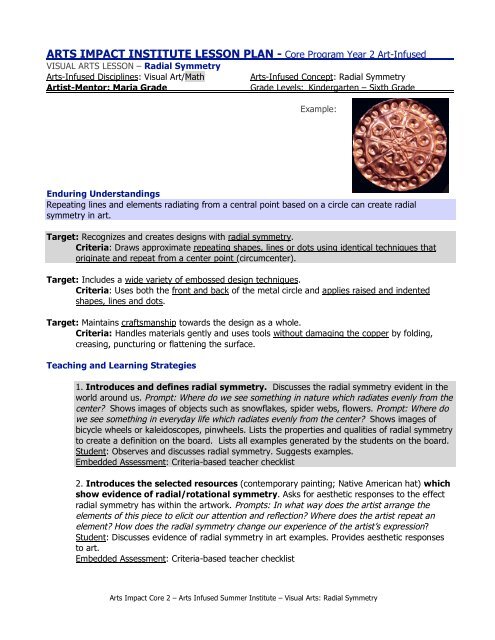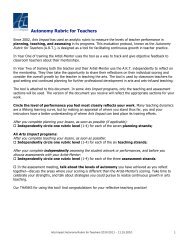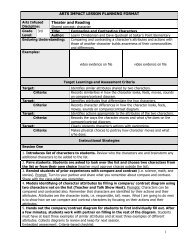Radial Symmetry ARTS - Arts Impact
Radial Symmetry ARTS - Arts Impact
Radial Symmetry ARTS - Arts Impact
You also want an ePaper? Increase the reach of your titles
YUMPU automatically turns print PDFs into web optimized ePapers that Google loves.
<strong>ARTS</strong> IMPACT INSTITUTE LESSON PLAN - Core Program Year 2 Art-Infused<br />
VISUAL <strong>ARTS</strong> LESSON – <strong>Radial</strong> <strong>Symmetry</strong><br />
<strong>Arts</strong>-Infused Disciplines: Visual Art/Math <strong>Arts</strong>-Infused Concept: <strong>Radial</strong> <strong>Symmetry</strong><br />
Artist-Mentor: Maria Grade Grade Levels: Kindergarten – Sixth Grade<br />
Example:<br />
Enduring Understandings<br />
Repeating lines and elements radiating from a central point based on a circle can create radial<br />
symmetry in art.<br />
Target: Recognizes and creates designs with radial symmetry.<br />
Criteria: Draws approximate repeating shapes, lines or dots using identical techniques that<br />
originate and repeat from a center point (circumcenter).<br />
Target: Includes a wide variety of embossed design techniques.<br />
Criteria: Uses both the front and back of the metal circle and applies raised and indented<br />
shapes, lines and dots.<br />
Target: Maintains craftsmanship towards the design as a whole.<br />
Criteria: Handles materials gently and uses tools without damaging the copper by folding,<br />
creasing, puncturing or flattening the surface.<br />
Teaching and Learning Strategies<br />
1. Introduces and defines radial symmetry. Discusses the radial symmetry evident in the<br />
world around us. Prompt: Where do we see something in nature which radiates evenly from the<br />
center? Shows images of objects such as snowflakes, spider webs, flowers. Prompt: Where do<br />
we see something in everyday life which radiates evenly from the center? Shows images of<br />
bicycle wheels or kaleidoscopes, pinwheels. Lists the properties and qualities of radial symmetry<br />
to create a definition on the board. Lists all examples generated by the students on the board.<br />
Student: Observes and discusses radial symmetry. Suggests examples.<br />
Embedded Assessment: Criteria-based teacher checklist<br />
2. Introduces the selected resources (contemporary painting; Native American hat) which<br />
show evidence of radial/rotational symmetry. Asks for aesthetic responses to the effect<br />
radial symmetry has within the artwork. Prompts: In what way does the artist arrange the<br />
elements of this piece to elicit our attention and reflection? Where does the artist repeat an<br />
element? How does the radial symmetry change our experience of the artist’s expression?<br />
Student: Discusses evidence of radial symmetry in art examples. Provides aesthetic responses<br />
to art.<br />
Embedded Assessment: Criteria-based teacher checklist<br />
<strong>Arts</strong> <strong>Impact</strong> Core 2 – <strong>Arts</strong> Infused Summer Institute – Visual <strong>Arts</strong>: <strong>Radial</strong> <strong>Symmetry</strong>
3. Discusses the tradition of radial symmetry in the art of many cultures throughout<br />
history and the beliefs which are connected to those art forms. Displays Rangoli, Mandala,<br />
Hex, Millefiori, Tapa, Quilt, Arabic and Gothic design examples.<br />
Student: Observes the traditional uses of radial symmetry in art and discusses the range of<br />
purposes and beliefs.<br />
4. Introduces the copper material and the tradition of repoussé. Prompts: Repoussé<br />
means to ‘push back’ in French. This method often includes both embossing and indenting a<br />
metal surface from both sides to create a slightly projecting relief surface. What do you see in<br />
the center of this gold repoussé example? Show the Hellenistic Phiale. Prompts: We do not<br />
know the specific artist, only that it was created around 300 BC. Art historians have found that<br />
it is meant to represent the navel of the universe. All around the navel are symmetrically<br />
arranged bees and acorns. What do you think that might mean? (plenty of food) How does this<br />
radially symmetrical arrangement express to, or tell, the viewer more about the way Hellenistic<br />
artists saw the world?<br />
Student: Discusses the radial design and qualities of the repoussé technique.<br />
5. Demonstrates the division of a copper circle with a template and the application<br />
of the center design. The even number of sections will vary with the artistic developmental<br />
growth of each group of students. Demonstrates the varied uses of stylus tool, addition of<br />
layers and the reversal of the copper to include both embossing and indenting in the finished<br />
design. Prompts: I am making sure to include a variety of design elements that I invent like<br />
dots and tiny shapes and stars. I complete a whole layer of the same one element before I go<br />
onto my next idea. Each time, I’m checking to see if the repetition falls on a rotation that can be<br />
found in each section. I am not sure that I can draw the exact same bee each time so I am not<br />
going to try to do anything too complicated for this design. I have some raised details and some<br />
pushed in details for greater interest. Shows before and after design examples. Models selfassessment<br />
and subsequent refinement of design to meet criteria. Models journal entry to<br />
reflect on their design and document potential personal meaning.<br />
Student: Observes demonstration; suggests ideas for elements to add and what to avoid.<br />
Embedded Assessment: Criteria-based self-assessment; journal reflection<br />
6. Teacher: Demonstrates and encourages use of all tools and experimentation<br />
beforehand on scrap pieces to establish the pressure needed. Leads class in<br />
experimentation on scrap copper pieces with a stylus tool.<br />
Student: Observes and discusses process, experiments on scrap copper.<br />
7. Teacher: Distributes materials and guides class through the process of tracing the<br />
edges of the template to create clear pie-shaped sections which meet at the center point.<br />
Directs students to create a center/navel/seed design.<br />
Student: Organizes materials and traces even sections onto the copper circle. Creates a center<br />
design to begin the artwork.<br />
Embedded Assessment: Criteria-based self assessment; teacher checklist; journal reflection<br />
8. Teacher: Initiates a quiet, contemplative design process for the class with music to<br />
encourage focus. Advises students during the process of doing their repoussé designs,<br />
brainstorming ways to edit or enhance faint marks or stray non-symmetrical elements so that<br />
they will meet criteria.<br />
Student: Creates design and refines it, following self assessment. Documents through use of a<br />
journal entry the personal meaning of various design elements.<br />
Embedded Assessment: Criteria-based self assessment; teacher checklist; journal reflection<br />
<strong>Arts</strong> <strong>Impact</strong> Core 2 – <strong>Arts</strong> Infused Summer Institute – Visual <strong>Arts</strong>: <strong>Radial</strong> <strong>Symmetry</strong>
9. Teacher: Leads a group critique of the radial designs, remarking on successful evidence<br />
of the meeting of criteria. Prompt: Where do we see successful use of a variety of inventive<br />
designs, of raised designs, of indented designs, of especially careful attention to symmetry and<br />
craftsmanship?<br />
Student: Criteria-based peer critique<br />
Vocabulary Materials and Community Resource WA Essential Learnings & Frameworks<br />
<strong>Arts</strong> Infused: Visual<br />
Art and Math:<br />
balance, central<br />
point, radial<br />
symmetry,<br />
repetition, rotation<br />
Visual Art:<br />
craftsmanship<br />
emboss<br />
indent<br />
relief<br />
repousse<br />
repoussage<br />
stylus<br />
Museum Artworks:<br />
Tacoma Art Museum<br />
Egg and Cross, 1995<br />
Michael Gregory<br />
Seattle Art Museum<br />
Painted Wooden Hat, 1895;<br />
Charles Edansaw<br />
Tile with twelve-pointed star, 15th century<br />
Persian<br />
39.61<br />
Internet and books: Metropolitan Museum of Art,<br />
Hellenistic Phiale, 300 BC; other photos of cultural<br />
examples of radial symmetry: Rangoli, Mandala, Hex,<br />
Millefiori, Tapa, Quilt, Arabic and Gothic designs.<br />
Art Materials: copper 36 gauge cut into 6” circles,<br />
steel stylus tools, Fun Foam sheets, rulers, templates,<br />
copper tape for edges (optional)<br />
Essential Learnings<br />
AEL 1.1 concepts: radial symmetry, repetition<br />
AEL 1.1.2 principles of organization: balance,<br />
rotation<br />
AEL 1.2 skills and techniques: repoussé<br />
AEL 3.2 for a purpose: personal meaning<br />
MEL 1.3: geometric sense: relationships and<br />
transformations: slides<br />
<strong>Arts</strong> State Frameworks<br />
Kindergarten: uses repetition of one element to<br />
create pattern<br />
Grade 1: uses repetition of several elements to<br />
create pattern<br />
Grade 4: identifies and demonstrates symmetrical<br />
(formal) radial balance in two dimensions<br />
Grade 5: identifies and applies principles of balance<br />
and repetition in an artwork<br />
Grade 6: identifies rotation<br />
Math State Frameworks<br />
Grade 3: draws a shape that is congruent to a given<br />
two-dimensional shape; uses attributes and<br />
properties to identify, name, draw, compare, and/or<br />
sort two-dimensional shapes and figures<br />
Grade 4: identify and draw a line of symmetry;<br />
identify symmetrical two-dimensional figures and<br />
shapes; complete a design from a variety of cultures<br />
that incorporate a line of symmetry (e.g. basket<br />
design); compare attributes of congruent figures in<br />
multiple orientations; simulate translations and<br />
reflections; create design using translations and<br />
reflections<br />
Grade 5: identify a specific transformation as a<br />
translation (slide) or reflection (flip); draw congruent<br />
figures and shapes in multiple orientations using a<br />
transformation; create designs using translations<br />
and/or reflections<br />
<strong>Arts</strong> <strong>Impact</strong> Core 2 – <strong>Arts</strong> Infused Summer Institute – Visual <strong>Arts</strong>: <strong>Radial</strong> <strong>Symmetry</strong>
TRANSFORMATION DEFINITIONS<br />
transformation (geometric): A change in position/location of a figure. Types of transformations<br />
include translation (slide), reflection (flip), rotation (turn), (or combinations of these).<br />
translation/slide: A transformation of a figure by sliding without turning or flipping in any direction.<br />
Example:<br />
translation<br />
reflection or reflection on a line: A transformation of a figure by flipping the figure over a line,<br />
creating a mirror image.<br />
Examples:<br />
rotation/turn: A transformation of a figure (or points) in a plane resulting from turning a figure<br />
around a center point 0—either clockwise counterclockwise.<br />
Example:<br />
point O<br />
<strong>Arts</strong> <strong>Impact</strong> Core 2 – <strong>Arts</strong> Infused Summer Institute – Visual <strong>Arts</strong>: <strong>Radial</strong> <strong>Symmetry</strong>
<strong>ARTS</strong> IMPACT INSTITUTE LESSON PLAN<br />
VISUAL <strong>ARTS</strong> LESSON – <strong>Radial</strong> <strong>Symmetry</strong><br />
ASSESSMENT WORKSHEET<br />
1.<br />
2.<br />
3.<br />
4.<br />
5.<br />
6.<br />
7.<br />
8.<br />
9.<br />
10.<br />
11.<br />
12.<br />
13.<br />
14.<br />
15.<br />
16.<br />
17.<br />
18.<br />
19.<br />
20.<br />
21.<br />
22.<br />
23.<br />
Total<br />
Percentage<br />
Students<br />
<strong>Symmetry</strong><br />
VISUAL ART<br />
Describes repeating<br />
shapes or lines that<br />
originate and repeat<br />
from a center point<br />
<strong>Symmetry</strong><br />
MATH<br />
Draws approximate<br />
repeating shapes,<br />
lines or dots using<br />
identical techniques<br />
that originate and<br />
repeat from a center<br />
point<br />
Repoussé<br />
Techniques<br />
VISUAL ART<br />
Uses both the front<br />
and back of the<br />
metal circle and<br />
applies raised and<br />
indented shapes,<br />
lines and dots.<br />
Craftsmanship<br />
VISUAL ART<br />
Handles materials gently<br />
and uses tools without<br />
damaging the copper by<br />
folding, creasing,<br />
puncturing or flattening the<br />
surface<br />
Criteria-based Reflection Questions: (Note examples of student reflections.)<br />
Self-Reflection: What radial symmetry elements did you repeat? What personal meaning do<br />
they hold for you?<br />
Peer to Peer: Where did you see careful attention to symmetry in the work of your peers?<br />
Thoughts about Learning:<br />
Which prompts best communicated concepts? Which lesson dynamics helped or hindered learning?<br />
Lesson Logistics:<br />
Which classroom management techniques supported learning?<br />
Teacher: Date:<br />
<strong>Arts</strong> <strong>Impact</strong> Core 2 – <strong>Arts</strong> Infused Summer Institute – Visual <strong>Arts</strong>: <strong>Radial</strong> <strong>Symmetry</strong><br />
Total<br />
Points<br />
4
<strong>ARTS</strong> IMPACT INSTITUTE LESSON PLAN<br />
VISUAL <strong>ARTS</strong> LESSON – <strong>Radial</strong> <strong>Symmetry</strong><br />
ASSESSMENT WORKSHEET<br />
Student Name:<br />
<strong>Symmetry</strong><br />
VISUAL ART<br />
Describes repeating<br />
shapes or lines that<br />
originate and repeat<br />
from a center point<br />
<strong>Symmetry</strong><br />
MATH<br />
Draws approximate<br />
repeating shapes,<br />
lines or dots using<br />
identical techniques<br />
that originate and<br />
repeat from a center<br />
point<br />
Repoussé<br />
Techniques<br />
VISUAL ART<br />
Uses both the front<br />
and back of the<br />
metal circle and<br />
applies raised and<br />
indented shapes,<br />
lines and dots.<br />
Criteria-based Reflection Questions:<br />
Self-Reflection: What radial symmetry elements did you repeat?<br />
What personal meaning do they hold for you?<br />
Craftsmanship<br />
VISUAL ART<br />
Handles materials gently<br />
and uses tools without<br />
damaging the copper by<br />
folding, creasing,<br />
puncturing or flattening the<br />
surface<br />
Peer to Peer: Where did you see careful attention to symmetry in the work of your peers?<br />
<strong>Arts</strong> <strong>Impact</strong> Core 2 – <strong>Arts</strong> Infused Summer Institute – Visual <strong>Arts</strong>: <strong>Radial</strong> <strong>Symmetry</strong><br />
Total<br />
Points<br />
4
<strong>Arts</strong> <strong>Impact</strong> Core 2 – <strong>Arts</strong> Infused Summer Institute – Visual <strong>Arts</strong>: <strong>Radial</strong> <strong>Symmetry</strong>
<strong>ARTS</strong> IMPACT FAMILY LETTER<br />
VISUAL <strong>ARTS</strong> LESSON – <strong>Radial</strong> <strong>Symmetry</strong><br />
Dear Family:<br />
Today your child participated in a visual arts lesson integrated with math. We studied radial<br />
symmetry in visual art and math.<br />
• We looked at a Native American hat and a contemporary painting and found the ways the<br />
artists used radial symmetry and how it adds visual interest. We also looked at radial symmetry<br />
in visual art examples from around the world and the different meanings associated with those<br />
designs.<br />
• We each made a copper Repoussage. This is a piece of art produced by a metal working<br />
process known as Repousse. Repoussé means to ‘push back’ in French. This method often<br />
includes both embossing and indenting a metal surface from both sides to create a slightly<br />
projecting relief surface.<br />
• We incorporated a radial symmetry design repeating shapes, lines and dots in different sections<br />
of the design around a central point.<br />
• We practiced artistic craftsmanship. We used the copper material carefully so that we would<br />
not damage it as we worked with it.<br />
At home, you could look for examples of radial symmetry in nature and in the objects around you.<br />
Enduring Understanding<br />
Repeating lines and elements radiating from a central point based on a circle can create radial<br />
symmetry in art.<br />
<strong>Arts</strong> <strong>Impact</strong> Core 2 – <strong>Arts</strong> Infused Summer Institute – Visual <strong>Arts</strong>: <strong>Radial</strong> <strong>Symmetry</strong>
















